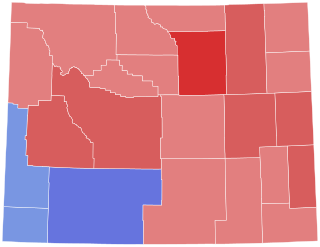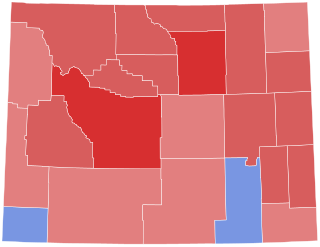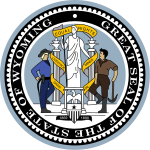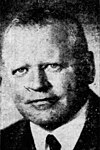
The 1942 United States Senate election in Wyoming was held on November 3, 1942. Democratic Senator Harry Schwartz ran for re-election to his second term. He was challenged by businessman Edward V. Robertson, who emerged from a close and hotly contested Republican primary as the narrow winner. Aided in part by the national swing toward Republicans in 1942, Robertson defeated Schwartz for re-election by a decisive margin.

The 1930 Wyoming gubernatorial election took place on November 4, 1930. Incumbent Republican Governor Frank Emerson ran for re-election. As was the case with Emerson's first election in 1926, he faced a tight race. He was opposed by State Senator Leslie A. Miller, the Democratic nominee. Ultimately, Emerson narrowly won re-election over Miller, winning 51-49%, and by a margin of just 870 votes. However, Emerson did not end up serving his full term; he died on February 18, 1931, just a few weeks into his second term, triggering a special election in 1932.

The 1934 Wyoming gubernatorial election took place on November 6, 1934. Incumbent Democratic Governor Leslie A. Miller ran for re-election to his second term, and his first full term, following his initial election in the 1932 special election. Miller faced Republican Alonzo M. Clark, his predecessor as governor, in the general election. Despite the closeness of Miller's first election, he took advantage of the nationwide Democratic landslide and easily defeated Clark.

The 1938 Wyoming gubernatorial election took place on November 8, 1938. Incumbent Democratic Governor Leslie A. Miller ran for re-election to his third term, and his second full term. Nels H. Smith, a former State Representative and former state highway commissioner, won a crowded Republican primary and advanced to the general election against Miller. Though Miller won his re-election campaign four years earlier in a landslide, Smith was able to take advantage of the nationwide Republican wave to defeat him in a landslide, winning 60% of the vote to Governor Miller's 40%.

A general election was held in the U.S. state of Wyoming on Tuesday, November 2, 2010. All of the state's executive officers—the Governor, Secretary of State, Auditor, Treasurer, and Superintendent of Public Instruction—were up for election.

A general election was held in the U.S. state of Wyoming on Tuesday, November 7, 2006. All of the state's executive officers—the Governor, Secretary of State, Auditor, Treasurer, and Superintendent of Public Instruction—were up for election.

A general election was held in the U.S. state of Wyoming on Tuesday, November 2, 1926. All of the state's executive officers—the Governor, Secretary of State, Auditor, Treasurer, and Superintendent of Public Instruction—were up for election. Republicans narrowly picked up the governorship and solidified their control on the other statewide offices, increasing their margin of victory in each race.

A general election was held in the U.S. state of Wyoming on Tuesday, November 4, 1930. All of the state's executive officers—the Governor, Secretary of State, Auditor, Treasurer, and Superintendent of Public Instruction—were up for election. Republicans narrowly held onto the Governor's office and won every other state office.

A general election was held in the U.S. state of Wyoming on Tuesday, November 6, 1934. All of the state's executive officers—the Governor, Secretary of State, Auditor, Treasurer, and Superintendent of Public Instruction—were up for election. In the 1932 gubernatorial special election, the Democratic candidate, Leslie A. Miller, won and ran for re-election for a full term in 1934. The Democratic Party also won elections for Secretary of State, Auditor, Treasurer, and Superintendent of Public Instruction, flipping those offices from the Republican Party.

A general election was held in the U.S. state of Wyoming on Tuesday, November 3, 1942. All of the state's executive officers—the governor, secretary of state, auditor, treasurer, and superintendent of public instruction—were up for election. Like the 1938 elections, this year's elections were something of a mixed bag for both parties. Democratic secretary of state Lester C. Hunt successfully defeated Republican governor Nels H. Smith for re-election, but Republicans flipped the secretary of state's office in Hunt's absence. The other incumbents—State Auditor William M. Jack, a Democrat, and Superintendent Esther L. Anderson, a Republican—were re-elected, and Republicans held onto the state treasurer's office.

A general election was held in the U.S. state of Wyoming on Tuesday, November 5, 1946. All of the state's executive officers—the governor, secretary of state, auditor, treasurer, and superintendent of public instruction—were up for election. The election was largely a rout for the Republican Party. Though Democratic governor Lester C. Hunt was narrowly re-elected, Democrats lost their two other state offices: auditor and secretary of State. Moreover, they were unable to win back any other state offices.

A general election was held in the U.S. state of Wyoming on Tuesday, November 7, 1950. All of the state's executive officers—the governor, secretary of state, auditor, treasurer, and superintendent of public instruction—were up for election. The Republican Party swept all of the offices. Following Democratic governor Lester C. Hunt's election to the U.S. Senate in 1948, Republican secretary of state Arthur G. Crane had been acting as governor. Republican Congressman Frank A. Barrett was elected governor, and Republican candidates won the other statewide races.

A general election was held in the U.S. state of Wyoming on Tuesday, November 2, 1954. All of the state's executive officers—the governor, secretary of state, auditor, treasurer, and superintendent of public instruction—were up for election. The result was largely a continuation of Republican rule, though Democrat Velma Linford won the election for Superintendent and the margins in most of the other races shrunk considerably from 1950.

A general election was held in the U.S. state of Wyoming on Tuesday, November 7, 1962. All of the state's executive officers—the Governor, Secretary of State, Auditor, Treasurer, and Superintendent of Public Instruction—were up for election. Republicans ran the table on the state's executive offices, defeating incumbent Governor Jack R. Gage and incumbent Superintendent Velma Linford and picking up the Secretary of State's office. Republican State Auditor Minnie A. Mitchell was re-elected and Republicans also held the Treasurer's office.

A general election was held in the U.S. state of Wyoming on Tuesday, November 8, 1966. All of the state's executive officers—the Governor, Secretary of State, Auditor, Treasurer, and Superintendent of Public Instruction—were up for election. After winning all of the statewide executive offices in 1962, Republicans did even better in 1966, improving their margins of victory in each race and holding all the offices.

A general election was held in the U.S. state of Wyoming on Tuesday, November 7, 1978. All of the state's executive officers—the Governor, Secretary of State, Auditor, Treasurer, and Superintendent of Public Instruction—were up for election. Democratic Governor Edgar Herschler won a narrow re-election to a second term, and Democrat Lynn Simons was elected Superintendent of Public Instruction, narrowly defeating incumbent Republican Robert G. Schroder. Republicans won the remainder of the statewide offices.

A general election was held in the U.S. state of Wyoming on Tuesday, November 2, 1982. All of the state's executive officers—the governor, secretary of state, auditor, treasurer, and superintendent of public instruction—were up for election. Democratic governor Edgar Herschler won a landslide victory on his way to a record third term in office and Democrat Lynn Simons, first elected in 1978 as superintendent of public instruction, won a sizable re-election as well. Republicans held the other statewide offices.

A general election was held in the U.S. state of Wyoming on Tuesday, November 7, 1922. All of the state's executive officers—the Governor, Secretary of State, Auditor, Treasurer, and Superintendent of Public Instruction—were up for election. Democrats improved considerably from their performances in 1918, with William B. Ross winning the gubernatorial election and almost all of their statewide candidates outpacing their 1918 nominees. However, Republicans held all of the other statewide offices.

A general election was held in the U.S. state of Wyoming on Tuesday, November 3, 1914. All of the state's executive officers—the Governor, Secretary of State, Auditor, Treasurer, and Superintendent of Public Instruction—were up for election. Governor Joseph M. Carey declined to seek re-election to a second term, and Democratic State Senator John B. Kendrick was elected as his successor. Republicans, however, won all of the other statewide executive offices, including picking up the Superintendent's office.

A general election was held in the U.S. state of Wyoming on Tuesday, November 5, 1918. All of the state's executive officers—the Governor, Secretary of State, Auditor, Treasurer, and Superintendent of Public Instruction—were up for election. Republicans won all statewide offices by wide margins, and with Robert D. Carey's defeat of Frank L. Houx, picked up the governorship following two consecutive losses to Democrats.








